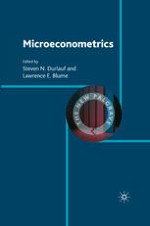2010 | OriginalPaper | Chapter
Proportional Hazard Model
Authors : Jerry A. Hausman, Tiemen M. Woutersen
Published in: Microeconometrics
Publisher: Palgrave Macmillan UK
Activate our intelligent search to find suitable subject content or patents.
Select sections of text to find matching patents with Artificial Intelligence. powered by
Select sections of text to find additional relevant content using AI-assisted search. powered by
The estimation of duration models has been the subject of significant research in econometrics since the late 1970s. Cox (1972) proposed the use of proportional hazard models in biostatistics and they were soon adopted for use in economics. Since Lancaster (1979), it has been recognized among economists that it is important to account for unobserved heterogeneity in models for duration data. Failure to account for unobserved heterogeneity causes the estimated hazard rate to decrease more with the duration than the hazard rate of a randomly selected member of the population. Moreover, the estimated proportional effect of explanatory variables on the population hazard rate is smaller in absolute value than that on the hazard rate of the average population member and decreases with the duration. To account for unobserved heterogeneity Lancaster proposed a parametric mixed proportional hazard (MPH) model, a partial generalization of Cox’s proportional hazard model, that specifies the hazard rate as the product of a regression function that captures the effect of observed explanatory variables, a baseline hazard that captures variation in the hazard over the spell, and a random variable that accounts for the omitted heterogeneity. In particular, Lancaster (1979) introduced the mixed proportional hazard model in which the hazard is a function of a regressor X unobserved heterogeneity v, and a function of time λ(f), (1)<math display='block'> <mrow> <mi>θ</mi><mrow><mo>(</mo> <mrow> <mi>t</mi><mo>|</mo><mi>X</mi><mo>,</mo><mi>v</mi> </mrow> <mo>)</mo></mrow><mo>=</mo><mi>v</mi><msup> <mi>e</mi> <mrow> <mi>X</mi><msub> <mi>β</mi> <mn>0</mn> </msub> </mrow> </msup> <mi>λ</mi><mrow><mo>(</mo> <mi>t</mi> <mo>)</mo></mrow><mo>.</mo> </mrow> </math>$$\theta \left( {t|X,v} \right)=v{{e}^{{X{{\beta }_{0}}}}}\lambda \left( t \right).$$
